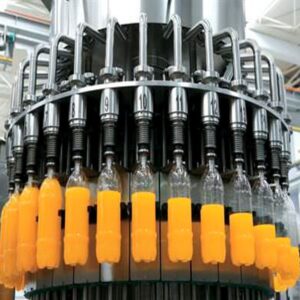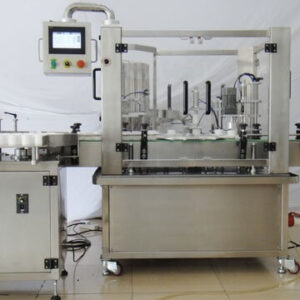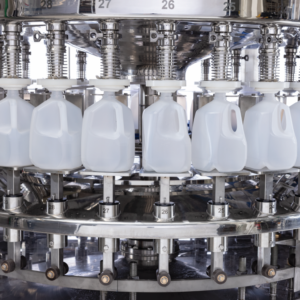Description
| Specification | Details |
|---|---|
| Filling Capacity | Variable, typically ranging from 1 to 20 liters |
| Filling Speed | Adjustable, up to X liters per minute |
| Bag Sizes Supported | Various sizes, typically from 1 to 20 liters |
| Material Compatibility | Compatible with FDA-approved food-grade materials such as PE, PET, and Nylon |
| Control System | PLC (Programmable Logic Controller) with touchscreen interface |
| Accuracy | Typically within ±0.5% of the target fill volume |
| Air Requirement | X bar (X PSI) clean, dry compressed air |
| Power Requirement | Variable, depending on machine size and configuration (e.g., 220V/50Hz/1Ph) |
| Construction Material | Stainless steel construction for durability and hygiene compliance |
| Cleaning System | CIP (Clean-in-Place) system for easy sanitation |
| Safety Features | Emergency stop button, safety interlocks, guarding, and overload protection |
| Optional Features | Date coding, nitrogen flushing, product heating/cooling, level sensing, etc. |
| Dimensions | Variable, depending on model and customization |
| Weight | Variable, depending on model and configuration |
| Manufacturer | [Manufacturer Name] |
| Model Number | [Model Number] |
-
- Automation of bag-in-box filling machines is a significant development in the dynamic packaging technology sector. It is a major leap forward for some of the leading companies like Koyo Machine Industries Co., Ltd. as one of the pioneers in this field. This article discusses various aspects of automatic bag-in-box filling machines, specifically those made by Koyo including their types, applications, functions, future trends, benefits, etc.
-
-
Different types of Automatic Bag-in-Box Filling Machines
- Automatic bag-in-box filling machines are divided into categories to fit specific needs and production volumes:
-
-
- Semi-Automatic Machines: These machines need some manual involvement typically at initial setup and loading of packaging materials but become automated during the filling and sealing processes hence output consistency and reduced labor cost.
- Fully Automatic Machines: These systems are advanced enough that they can initiate even material loading for packaging purposes through to sealing or even packaging whole process making them best suited for large volume production lines hence efficiency optimization and faster throughput.
- Aseptic Filling Machines: Aseptic bag-in-box filling machines maintain sterility throughout the packaging process which is crucial since industries such as food and pharmaceuticals require it. Product safety is maintained while the shelf life of products is increased through the application of advanced sterilization techniques by these machines.
- Multi-Head Filling Machines: Multi-head filling machines have several heads for simultaneous filling into different bags or pouches. They are designed to improve productivity hence appropriate for mass manufacturing activities.
-
Automatic Bag-in-Box Filling Machine Applications
- The versatility in their use makes automatic bag-in-box filling machines find wide application across various industries:
- Food & Beverage: Juices, dairy products, sauces, and liquid foods among others are packaged using automatic bag-in-box filling machines within the food & beverage industry. Due to its ability to package different viscosity levels without compromising on product quality; it can therefore have a wide range of uses.
- Pharmaceuticals: In the pharmaceutical industry, hygiene and dose precision are very crucial. Liquid pharmaceuticals like intravenous solutions or liquid medications can be packaged in sterile bags using an automatic bag-in-box filling machine with aseptic features.
- Chemicals & Cosmetics: Packaging for chemicals, detergents, and cosmetics should be such that they do not compromise on safety standards. Automatic bag-in-box filling machines guarantee accurate sealing and filling of these products during transit as they remain unopened.
- Agricultural Sector: Packets containing fertilizers, pesticides, or liquid supplements are among the agricultural product packaging needs that require improvement. These liquids need handling and distribution hence automated bag-in-box filling machines are helpful in this regard; thus enhancing convenience while minimizing environmental impacts.
-
Functions of Automatic Bag-in-Box Filling Machine
- The automatic bag-in-box filling machinery performs seamlessly through several operational stages to ensure efficient packaging:
- Material Feeding: The machine has systems that enable it to load packaging materials such as bags, pouches, and cartons. Some designs allow manual feeding while others are automated feeding systems using conveyors for example.
- Filling: It is at this point that the desired amount of product is filled into packaging containers using precise fillers like volumetric or gravimetric dosing systems. The filling process becomes more accurate due to the advanced sensors and controls used.
- Sealing: After filling the packages have to be sealed to prevent spillage as well as contamination. Heat-sealing or ultrasonic sealing methods are employed depending also on the nature of packing materials used.
- Sterilization (For Aseptic Machines): Sterilizing installations are integrated into aseptic bag-in-box filling machines to eliminate microorganisms during the packaging process. These include techniques like the use of steam sterilization, and hydrogen peroxide vapor as a way of achieving aseptic conditions.
-
Future trends in automatic bag-in-box filling machines
- Technological advancements and industry requirements drive the progression of automatic bag-in-box filling machines. Some of the key future trends include:
- Integration of Industry 4.0 Technologies: Some industries integrate IoT (Internet of Things), AI (Artificial Intelligence), and machine learning among other Industry 4.0 principles which enhance connectivity and data-driven insights. Smart automated filling systems optimize productions, predict maintenance needs, and increase overall efficiency.
- Eco-Friendly Packaging Solutions: Automatic Bag-In-Box Filling Machines will be more inclined to have facilities that can utilize recyclable and bio-degradable materials as there is an emphasis on sustainability today. This trend is coherent with eco-friendly demands across various sectors.
- Modular and Flexible Designs: The manufacturers are considering modular designs for customization or scaling purposes alike. Flexible automatic filling machines are capable of suiting different packaging patterns that change over time while minimizing any negative impact on production levels associated with alterations in product definition.
- Enhanced Hygiene and Safety Features: The hygiene level of automatic bag-in-box filling machines will continue to rise due to new developments in sterilization and sanitation technologies. It will be crucial in meeting regulatory standards for such industries as self-cleaning mechanisms or sanitation protocols built into them.
-
Advantages of Using Automatic Bag-In Box Filling Machines
- This implies that if companies choose to go this route, they would be able to reap the following benefits:
- Improved Efficiency: Streamlining production processes through automation reduces human power costs leading to higher throughput rates coupled with lower operational costs.
- Better Product Quality: Better sealing methods result in filling accuracy which helps in reducing contamination risks and product wastage hence ensuring integrity.
- Increased Flexibility: To improve production, auto-filling systems can be designed for a range of packaging types or product specifications.
- Extended Shelf Life: Aseptic filling offers several advantages. These include preservation of freshness, extended shelf life, and reduction of food waste.
- Regulatory Compliance: Advanced features such as traceability and batch tracking help in meeting regulatory standards and quality control measures.
-
Sеlling Automatic Bag in Box Filling Machine Linеs Globally
- This piece of equipment has changed the way companies package their products across the world; this is evident in major cities within the United States like New York City, Los Angeles, and Chicago which have embraced these new ideas for efficient production. Examples of such Canadian cities include Toronto, Vancouver, and Montreal which employ automatic bag-in-box filling machines in sectors ranging from food and beverages to pharmaceuticals. Major Asia-Pacific countries like China, Japan, and India have witnessed widespread adoption of such machines in Beijing, Tokyo, and Mumbai respectively due to rapid industrialization and increased demand for packaged goods.
- European countries such as Germany, France, and the United Kingdom make extensive use of automatic bag-in-box filling machines, especially in Berlin, Paris, or London where they support different manufacturing sectors. The Gulf countries (Saudi Arabia, UAE, and Qatar) also have adopted this technology with Riyadh, Dubai, or Doha being some of the cities where it is used extensively thereby boosting oil & gas industry growth along with FMCG and cosmetics sector expansion. This has led to Australian towns including Sydney Melbourne Brisbane utilizing these devices throughout industries demonstrating their significance globally when it comes to packing materials.
-
FAQs
-
What is an automatic bag-in-box filling machine?
- An automatic bag-in-box filling machine is a highly specialized packaging equipment designed to fill and seal bags or pouches containing liquids or semi-liquids, commonly found in the food and beverage, pharmaceuticals, and chemicals industries.
-
How do automatic bag-in-box filling machines work?
- Simply said, these machines first load empty bags or pouches onto a conveyor system. The filled products are dispensed into the bags using accurate dosing mechanisms after which the bag is closed to limit the escape of fluid and any contamination. Some of the machines may also have aseptic packaging sterilization modules on them.
-
Which products can be put inside automatic bag-in-box filling machines?
- For example, automatic bag-in-box filling machines are used for many types of juices, dairy products, sauces, liquid foods, pharmaceuticals, chemicals, and cosmetics.
-
What are some advantages that come with using an automatic bag-in-box filling machine?
- These include improved product quality and consistency as well as better efficiency leading to increased production outputs. They also enable extended shelf life for products; minimize labor costs; and comply with regulatory standards.
-
Can automatic bag-in-box filling machines be customized?
- Certainly! Numerous producers proffer a range of customization options so that they can adapt their machinery for particular manufacturing requirements including different sizes of bags, volume fillings, and ways of sealing.
-
How do I choose an appropriate automatic bag-in-box filling machine for my company?
- Some factors to consider when choosing the right equipment include production volumes; product viscosity levels and acidity levels; packaging material compatibility; level of automation required; and cost constraints.
-
Do automatic bag-in-box filling machines need much maintenance?
- Most modern-day gadgets are made with easy-to-maintain designs and they come equipped with self-cleaning systems in place. Additionally, components have been placed in such a manner that servicing is quite easy while diagnostic tools help in quick identification and resolving problems whenever they arise.
-
Can automatic bag-in-box filling machines fit within my existing production line?
- Yes, many machines are manufactured with the sole purpose of seamlessly fitting into other existing production processes and this is achieved through compatibility with different conveyor systems and other packing equipment.
-
What safety features should a bag-in-box filling machine have?
- Some important safety features include emergency stop buttons, mechanical guarding to prevent access to moving parts during operation, and adherence to industry standards governing electrical and mechanical safety.
-
How long does an automatic bag-in-box filling machine last?
- The length of time depends on maintenance practices, usage frequency as well as the quality of the machine. However, if properly taken care of, a well-constructed device may be used for several years thereby providing a good return on investment.





